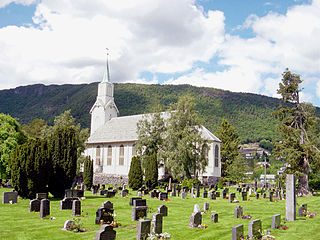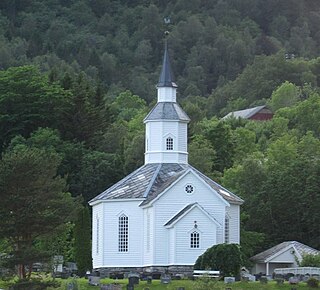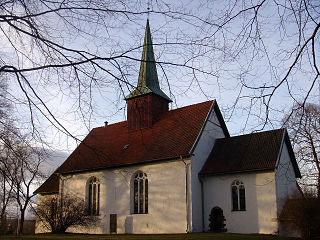
Orkdal Church is a parish church of the Church of Norway in Orkland municipality in Trøndelag county, Norway. It is located in the village of Fannrem, about 6 kilometres (3.7 mi) south of the town of Orkanger. It is the main church for the Orkdal parish as well as the seat of the Orkdal prosti (deanery) within the Diocese of Nidaros. The gray, stone, neo-Gothic church was built in a long church design in 1893 using plans drawn up by the architect Carl Julius Bergstrøm (1828–1898). The church seats about 450 people.

Kleive Church is a parish church of the Church of Norway in Molde Municipality in Møre og Romsdal county, Norway. It is located in the village of Kleive, at the eastern end of the Fannefjorden. It is the church for the Kleive parish which is part of the Molde domprosti (arch-deanery) in the Diocese of Møre. The white, wooden church was built in an octagonal design in the Empire style in 1858 by an unknown architect. The church seats about 270 people.

Voll Church is a parish church of the Church of Norway in Rauma Municipality in Møre og Romsdal county, Norway. It is located in the village of Voll in the Måndalen valley. It is the church for the Voll parish which is part of the Indre Romsdal prosti (deanery) in the Diocese of Møre. The white, wooden church was built in a long church design in 1896 using plans drawn up by the architect Gabriel Smith from Ålesund. The church seats about 290 people, making it the largest church in Rauma.

Ørskog Church is a parish church of the Church of Norway in Ålesund Municipality in Møre og Romsdal county, Norway. It is located in the village of Sjøholt. It is the church for the Ørskog parish which is part of the Nordre Sunnmøre prosti (deanery) in the Diocese of Møre. The white, wooden church was built in a long church design in 1873 using plans drawn up by the architect Jacob Wilhelm Nordan. The church seats about 600 people.

Lavik Church is a parish church of the Church of Norway in Høyanger Municipality in Vestland county, Norway. It is located in the village of Lavik on the northern shore of the Sognefjorden. It is the church for the Lavik parish which is part of the Sunnfjord prosti (deanery) in the Diocese of Bjørgvin. The white, wooden church was built in an octagonal design in 1865 using plans drawn up by the architect Christian Heinrich Grosch. The church seats about 380 people.

Lindås Church is a parish church of the Church of Norway in Alver Municipality in Vestland county, Norway. It is located in the village of Lindås. It is one of the three churches for the Lindås parish which is part of the Nordhordland prosti (deanery) in the Diocese of Bjørgvin. The white, wooden, neo-Gothic church was built in a long church design in 1865 using plans drawn up by the architect Ole Syslak. The church seats about 370 people.

Old Moster Church is a parish church of the Church of Norway in Bømlo Municipality in Vestland county, Norway, and it is one of the oldest churches in all of Norway. It is located in the village of Mosterhamn on the island of Moster. It used to be the main church for the Moster parish which is part of the Sunnhordland prosti (deanery) in the Diocese of Bjørgvin. The white stone church was built in a long church design in the 12th century using plans drawn up by an unknown architect. The church seats about 80 people.

Hedrum Church is a medieval parish church of the Church of Norway in Larvik Municipality in Vestfold county, Norway. It is located in the village of Hedrum, along the river Numedalslågen. It is the church for the Hedrum parish which is part of the Larvik prosti (deanery) in the Diocese of Tunsberg. The red wood and brown/gray stone church was built in a Romanesque long church design around the year 1100 using plans drawn up by an unknown architect. The church seats about 300 people. As a medieval building, it automatically has protected cultural heritage status.

Mo Church is a parish church of the Church of Norway in Tokke Municipality in Telemark county, Norway. It is located in the village of Mo. It is one of the churches for the Eidsborg, Mo, og Skafså parish which is part of the Øvre Telemark prosti (deanery) in the Diocese of Agder og Telemark. The white, wooden church was built in a long church design in 1839 using plans drawn up by the architect Hans Linstow. The church seats about 132 people.

Eidanger Church is a parish church of the Church of Norway in Porsgrunn Municipality in Telemark county, Norway. It is located in the village of Eidanger. It is one of the churches for the Eidanger parish which is part of the Skien prosti (deanery) in the Diocese of Agder og Telemark. The white, stone church was built in a long church design around the year 1150 using plans drawn up by an unknown architect. The church seats about 200 people.

Svarstad Church is a parish church of the Church of Norway in Larvik Municipality in Vestfold county, Norway. It is located in the village of Svarstad. It is one of the churches for the Lardal parish which is part of the Larvik prosti (deanery) in the Diocese of Tunsberg. The white, wooden church was built in a long church design in 1657 using plans drawn up by an unknown architect. The church seats about 220 people.

Tanum Church is a parish church of the Church of Norway in Larvik Municipality in Vestfold county, Norway. It is located in the village of Tanum. It is the church for the Tanum parish which is part of the Larvik prosti (deanery) in the Diocese of Tunsberg. The white, wooden church was built in a long church design around the year 1100 using plans drawn up by an unknown architect. The church seats about 240 people.

Andebu Church is a parish church of the Church of Norway in Sandefjord Municipality in Vestfold county, Norway. It is located in the village of Andebu. It is the church for the Andebu parish which is part of the Sandefjord prosti (deanery) in the Diocese of Tunsberg. The white, stone church was built in a long church design around the year 1100 using plans drawn up by an unknown architect. The church seats about 300 people.

Nøtterøy Church is a parish church of the Church of Norway in Færder Municipality in Vestfold county, Norway. It is located in the village of Borgheim. It is one of the churches for the Nøtterøy parish which is part of the Tønsberg domprosti (deanery) in the Diocese of Tunsberg. The white, stone church was originally built with a long church design around the year 1100 using plans drawn up by an unknown architect. The church seats about 500 people.

Sem Church is a parish church of the Church of Norway in Tønsberg Municipality in Vestfold county, Norway. It is located in the village of Sem. It is one of the churches for the Sem parish which is part of the Tønsberg domprosti (deanery) in the Diocese of Tunsberg. The white, stone church was built in a long church design around the year 1100 using plans drawn up by an unknown architect. The church seats about 211 people.

Ramnes Church is a parish church of the Church of Norway in Tønsberg Municipality in Vestfold county, Norway. It is located in the village of Ramnes. It is the church for the Ramnes parish which is part of the Tønsberg domprosti (deanery) in the Diocese of Tunsberg. The white, stone church was built in a long church design around the year 1150 using plans drawn up by an unknown architect. The church seats about 234 people.

Nykirke Church is a parish church of the Church of Norway in Horten Municipality in Vestfold county, Norway. It is located in the village of Nykirke. It is the church for the Nykirke parish which is part of the Nord-Jarlsberg prosti (deanery) in the Diocese of Tunsberg. The white, stone church was built in a long church design around the year 1100 using plans drawn up by an unknown architect. The church seats about 140 people.

Holmestrand Church is a parish church of the Church of Norway in Holmestrand Municipality in Vestfold county, Norway. It is located in the town of Holmestrand. It is one of the churches for the Botne parish which is part of the Nord-Jarlsberg prosti (deanery) in the Diocese of Tunsberg. The white, wooden church was built in a Y-shaped design in 1674 using plans drawn up by the architect Christian Heinrich Grosch. The church seats about 300 people.

Hof Church is a parish church of the Church of Norway in Holmestrand Municipality in Vestfold county, Norway. It is located in the village of Hof. It is one of the churches for the "Hof, Vassås og Eidsfoss" parish which is part of the Nord-Jarlsberg prosti (deanery) in the Diocese of Tunsberg. The white, stone church was built in a long church design around the year 110 using plans drawn up by an unknown architect. The church seats about 210 people.

Sande Church is a parish church of the Church of Norway in Holmestrand Municipality in Vestfold county, Norway. It is located in the village of Sande i Vestfold. It is the church for the Sande parish which is part of the Nord-Jarlsberg prosti (deanery) in the Diocese of Tunsberg. The white, stone church was built in a long church design around the year 1150 using plans drawn up by an unknown architect. The church seats about 350 people.































